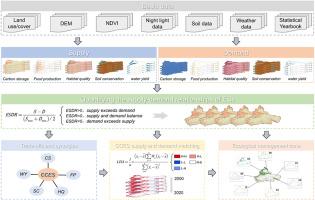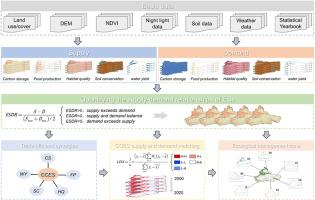A carbon-centered framework for ecosystem service supply-demand analysis in arid China: Insights for ecological zoning under dual carbon goals
IF 10
1区 环境科学与生态学
Q1 ENGINEERING, ENVIRONMENTAL
引用次数: 0
Abstract
Climate change and global carbon neutrality commitments have heightened the importance of ecosystem services in sustaining human well-being and mitigating climate impacts. Major economies, including China, have set dual carbon goals (emission peak and carbon neutrality) that underscore the role of ecosystems as natural carbon sinks and providers of essential services. However, the supply and demand of these services in arid, climate-sensitive regions remain poorly understood under these goals. This study addresses the gap by developing a carbon-centered framework to analyze ecosystem service supply–demand dynamics in Northwest China's arid region, a representative dryland area. Using integrated remote sensing data, the InVEST model, and statistical analyses, we quantified five key ecosystem services– carbon storage, water yield, soil conservation, food production, and habitat quality – and assessed their supply and demand from 2000 to 2020. The results show that ecosystem carbon storage increased by approximately 0.26 billion metric tons over two decades, reflecting notable gains in natural carbon sequestration. Water resources, in contrast, exhibited a persistent supply–demand imbalance, with water supply consistently falling short of societal demand. We also found pronounced spatial mismatches: areas of high service supply (e.g. mountainous and oasis regions) often did not overlap with areas of high demand (irrigated farmlands and cities). These misalignments endured despite improvements in vegetation cover and climate conditions. Our findings provide insights for ecological zoning and management in arid regions under carbon neutrality goals, suggesting that targeted strategies – from strengthening carbon sink conservation to balancing water resource allocation – are needed to align ecosystem service supply with societal needs in drylands.


以碳为中心的中国干旱生态系统服务供需分析框架:双碳目标下生态区划的启示
气候变化和全球碳中和承诺凸显了生态系统服务在维持人类福祉和减轻气候影响方面的重要性。包括中国在内的主要经济体设定了双重碳目标(排放峰值和碳中和),强调生态系统作为天然碳汇和基本服务提供者的作用。然而,在这些目标下,这些服务在干旱、气候敏感地区的供应和需求仍然知之甚少。本研究通过构建以碳为中心的框架来分析中国西北干旱区生态系统服务供需动态,从而弥补了这一空白。利用综合遥感数据、InVEST模型和统计分析,我们量化了五种关键的生态系统服务——碳储量、水量、土壤保持、粮食生产和栖息地质量——并评估了它们在2000 - 2020年间的供需情况。结果表明,20年来生态系统碳储量增加了约2.6亿公吨,反映了自然碳固存的显著增加。相比之下,水资源表现出持续的供需不平衡,水供应一直低于社会需求。我们还发现了明显的空间不匹配:高服务供应地区(如山区和绿洲地区)通常与高需求地区(灌溉农田和城市)不重叠。尽管植被覆盖和气候条件有所改善,但这些偏差仍然存在。我们的研究结果为干旱地区在碳中和目标下的生态区划和管理提供了见解,表明需要有针对性的策略——从加强碳汇保护到平衡水资源分配——来使干旱地区的生态系统服务供应与社会需求保持一致。
本文章由计算机程序翻译,如有差异,请以英文原文为准。
求助全文
约1分钟内获得全文
求助全文
来源期刊

Journal of Cleaner Production
环境科学-工程:环境
CiteScore
20.40
自引率
9.00%
发文量
4720
审稿时长
111 days
期刊介绍:
The Journal of Cleaner Production is an international, transdisciplinary journal that addresses and discusses theoretical and practical Cleaner Production, Environmental, and Sustainability issues. It aims to help societies become more sustainable by focusing on the concept of 'Cleaner Production', which aims at preventing waste production and increasing efficiencies in energy, water, resources, and human capital use. The journal serves as a platform for corporations, governments, education institutions, regions, and societies to engage in discussions and research related to Cleaner Production, environmental, and sustainability practices.
 求助内容:
求助内容: 应助结果提醒方式:
应助结果提醒方式:


